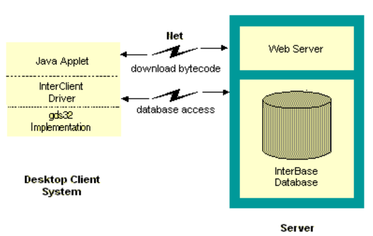Programming with InterClient
Go Up to Programming with JDBC
As an all-Java JDBC driver, InterClient enables platform-independent, client/server development for the Internet and corporate intranets. The advantage of an all-Java driver versus a native-code driver is that you can deploy InterClient-based applets without having to manually load platform-specific JDBC drivers on each client system. Web servers automatically download the InterClient classes along with the applets. Therefore, there is no need to manage local native database libraries, which simplifies administration and maintenance of customer applications. As part of a Java applet, InterClient can be dynamically updated, further reducing the cost of application deployment and maintenance.
InterClient allows Java applets and applications to:
- Open and maintain a high-performance, direct connection to an InterBase database server.
- Bypass resource-intensive, stateless Web server access methods.
- Allow higher throughput speeds and reduced Web server traffic.
InterBase developers who are writing new Java-based client programs can use InterClient to access their existing InterBase databases. Because InterClient is an all-Java driver, it can also be used on the Sun NC (Network Computer), a desktop machine that runs applets. The NC has no hard drive or CD ROM; users access all of their applications and data via applets downloaded from servers.
InterClient Architecture
The InterClient product consists of a client-side Java package called InterClient, which contains a library of Java classes that implement most of the JDBC API and a set of extensions to the JDBC API. This package interacts with the JDBC Driver Manager to allow client-side Java applications and applets to interact with InterBase databases.
Developers can deploy InterClient-based clients in two ways:
- As Java applets, which are Java programs that can be included in an HTML page with the
<APPLET>tag, served via a web server, and viewed and used on a client system using a Java-enabled web browser. This deployment method does not require manual installation of the InterClient package on the client system. It does require a Java-enabled browser and the JDBC Driver Manager to be installed on the client system. - As Java applications, which are stand-alone Java programs for execution on a client system. This deployment method requires the InterClient package, the JDBC Driver Manager, and the Java Runtime Environment (JRE), which is part of the Java Developer's Kit (JDK) installed on the client system.
InterClient Communication
InterClient is a driver for managing interactions between a Java applet or application and an InterBase database server. On a client system, InterClient works with the JDBC Driver Manager to handle client requests through the JDBC API. To access an InterBase database, InterClient communicates via a TCP/IP connection to the InterBase server and passes back the results to the InterClient process on the client machine.
